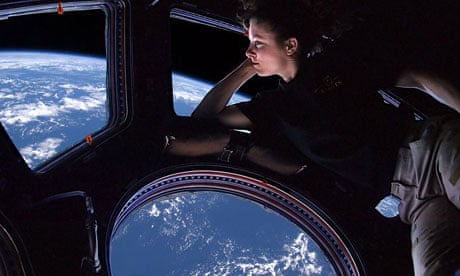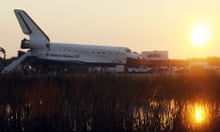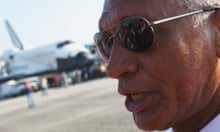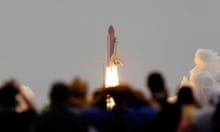This morning, the space shuttle Atlantis – "the last of the magnificent space flying rocket birds" – rolled to her final wheelstop. It's a tough day for those of us who count ourselves fans of manned space exploration, but something I heard on Nasa TV as the shuttle undocked from the International Space Station for the last time on Tuesday gave me hope.
After both the crew of Atlantis and mission controllers in Houston confirmed undocking, the familiar voice of the commentator came in: "Undocking confirmed at 1:28am central time. Atlantis weighs anchor from the International Space Station for the last time." A few moments later, a bell rang out. It was astronaut Ron Garan ringing the station's bronze ship's bell in the traditional farewell to a departing vessel.
I heard that "weighs anchor" as a reminder of the continuity of human exploration, and I heard that bell's ringing as a promise, to past, present and future generations, that our irrepressible human instinct to venture ever outward will not let us down.
Here's where I have to declare an interest with regard to this connection between sea and space voyaging. I collaborate with Nasa on space-to-sea science, education and outreach through my involvement with The HMS Beagle Project. I also want to reassure myself that the exploration instinct is an unbroken – and therefore unbreakable – theme of human history
It was with both of these interests in mind that I asked my HMS Beagle Project collaborator, Nasa astronaut Dr Michael Barratt, how he and his fellow astronauts felt about the connection:
Most all of us feel the heritage of sea voyaging in spaceflight. There are the everyday palpable aspects, such as the nautical terminology we use on board (port/starboard, fore/aft), the ship's bell we have on the station to ring visitors aboard and away, and the resemblance of vacuum packed crackers to ship's biscuits of old – every bit as tasty."
Then there are the more subtle but deeply rooted respect and faith one builds in one's ship, whether a shuttle or the station itself: an understanding you have that if you take care of her, she'll take you somewhere wonderful and bring you home safe. And of course, most of what we fly over is ocean, which as high as we are can sometimes be all we see of our planet."
The sea-space connection was a highlight of a recent visit to the UK by Barratt and the rest of the crew of the final flight of space shuttle Discovery, which came to her own historic wheelstop on 9 March. Ironically the visit coincided with the final launch of Atlantis, so the entire crew missed witnessing it in person.
Their consolation prizes included visits to one of their spaceship's namesakes, RRS Discovery in Dundee and the National Maritime Museum in Greenwich, where they returned the medal struck by the Royal Society in 1784 to commemorate Captain James Cook, having taken it with them into space.
Stretching the connection a bit further, I asked Barratt for his thoughts on the view from the station's recently installed cupola, the solar system's highest crow's nest. His reply was moving and descriptive:
If we could share only one experience from the station with everyone on Earth, it would be to spend an orbit in the cupola watching the 90-minute spectacle of the Earth going by. With the 'cathedral dome' layout of the windows, you take in the whole experience; the surface features, the horizon with the fragile appearance of the atmosphere, and the striking picture of the Earth as a planet hanging in the blackness of space.
During the shadow pass, all this transforms into city lights and lightning, a still perceptible atmospheric band often tinted green, and stars like you have never seen them. And the sun rising and setting is spectacular as well; just be ready to take this in quickly."
Oh, we are ready, and able, too, if only we can muster the will.







Comments (…)
Sign in or create your Guardian account to join the discussion